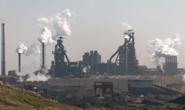Steel Mills

New Pig Iron Plant Possible in Ohio
Written by Sandy Williams
October 11, 2014
A new steel mill for Ohio, that has been in planning since 2005, is getting closer to reality but in a revised version.
New Steel International hoped to build a mini mill at Franklin Furnace in Scioto Country but it has agreed to downsize to a pig iron plant and a 300 megawatt cogeneration facility.
“That project was always a two-phase,” said Jason Kester, Director of the Southern Ohio Port Authority (SOPA). “The first phase was pig iron and electric generation. The second phase was steel. With today’s environment and realities, basically they’re focusing on the first phase which is electric generation and the pig iron, which would be about a 400 employee, couple of billion dollar project.”
In order to secure financing the New Steel International is urging the Ohio state legislature to pass House Bill 312 that would allow the Public Utilities Commission of Ohio (PUCO) to approve a rider on consumers’ electric bill for economic development purposes. Currently a rider is allowed but only on customers within the utilities’ service area. HB 312 would allow development funding to be raised through a rider on consumers across the state in order to lower individual per person cost.
State Senator Bill Seitz (R-Cincinnati) says the bill is too broad and is working with Ohio Representatives to limit the rider to $50 million and to customers in the territory of suppliers that enter into an agreement with New Steel to purchase electricity from its cogeneration facility.
Passage of the bill does not guarantee construction of the new mill but would open the way to additional funding.
The steel mill was originally conceived as a joint project with Russian steel producer Magnitogorsk Iron & Steel Works (MMK). Permits were applied for and received for an integrated steel mini-mill facility that would produce hot rolled, cold rolled and galvanized steel coils. The mill would be built in multiple phases and have an annual production capacity of 4 million metric tons. The final air permit was granted May 6, 2008.
The original plans included an iron making facility to produce DRI for the mill’s two electric arc furnaces. Included in the initial plans were:
• six rotary hearth furnaces and waste heat boilers;
• two electric arc furnaces;
• a thin slab continuous casting and hot rolling mill;
• a push-pull pickling line;
• an annealing line;
• a pickling, cold rolling and galvanizing/galvanneal line;
• and associated material handling operations.
The mill was estimated to cost approximately $6 billion to $7 billion to construct and would employ about 2000 people as well as 1500 workers during the construction phase.
MMK pulled out of the project in 2010 following the recession and the subsequent drop in steel demand.
In February of 2012, John Schultes, CEO of New Steel International was confident that plans for the new mill would move forward and vowed to work with Ohio legislators, local officials and utilities to obtain the necessary financing. “We will break ground sometime later this year,” he said. At the time, there was skepticism about the viability of a new plant in an environment of excess steel capacity as well as concerns from competition. “We are replacing imports with a project like this – so we’re not taking any capacity from existing operators,” said Shultes. The groundbreaking was put on hold.
In January 2014, Schultz said he and his partners were “very confident that we will get it done.”
Last week New Steel International said it would downsize the project, improving the odds that construction will occur. However, the company still needs to find utilities willing to purchase electricity from the plant before any further progress can be made. Schultz said he is confident the company will find utilities to partner with.

Sandy Williams
Read more from Sandy WilliamsLatest in Steel Mills

CRU: Tata Steel looks to shed 1,600 jobs in the Netherlands
The company said, “The challenging demand conditions in Europe driven by geopolitical developments, trade and supply chain disruptions and escalating energy costs have affected the operating costs and financial performance."

Reports: Federal funding for Cliffs’ project could be slashed
Elon Musk's DOGE is determining which Department of Energy grants to advance and which ones to terminate, according to several media outlets

Trump still against selling USS to Japanese firm: Report
Despite ordering a new review of Nippon Steel’s bid for U.S. Steel, President Trump said he is still against selling USS to a Japanese company, according to media reports.

Algoma looks to sell more steel in Canada in wake of Trump’s tariffs
The Canadian steelmaker said its absorbing higher tariffs as it moves forward.

Ancora abandons plan to take over leadership of USS
Investment firm Ancora Holdings Group has halted its play for U.S. Steel's board, citing Nippon Steel’s proposed bid for USS “gaining momentum.”
